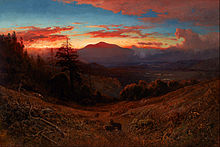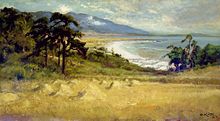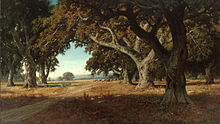William Keith
William Keith (born November 18, 1838 in Oldmeldrum , Aberdeenshire , United Kingdom of Great Britain and Ireland , † April 13, 1911 in Berkeley , California ) was a Scottish - American painter of the Düsseldorf School .
Life
Keith's father of the same name (1806–1838) died a few months before he was born. Keith's mother, Elizabeth Bruce (1810–1868), placed her son in the care of his grandparents. In 1850 she emigrated with all of her children to the United States, where the family settled in New York City . There Keith learned woodcut after completing school in 1856 . For the production of illustrations placed it then the Harper's Magazine in. In 1858 Keith traveled to Scotland and England , where he briefly worked for the London Daily News . In 1859 he went to San Francisco after receiving an offer from there. When this offer could not be realized, however, he stayed there and continued to work in the profession of xylography , in 1862 in a partnership with Harrison Eastman, in 1864 with Durbin Van Vleck. In 1863 he began to study painting with Samuel Marsden Brookes. He may have learned watercolor painting from Elizabeth Emerson, whom he married in 1864 . He exhibited his first watercolor paintings in 1866. In 1868 he began painting in oils . After he had received an order from the Oregon Navigation and Railroad Company to depict the Pacific Northwest in the same year , he decided to only work as a painter from then on.
In 1869 he went to Düsseldorf with his wife , whose art academy - especially as a result of the work of Emanuel Leutze , Albert Bierstadt and Worthington Whittredge - enjoyed an excellent, albeit waning, reputation in the United States. There he received private tuition from Albert Flamm , who was known as a landscape painter for his bright colors. He also got to know Andreas Achenbach's studio , whose free, “suggestive” painting he admired. His friend became his fellow student Carl Wilhelm Hahn , who followed him from Düsseldorf to the United States in 1871, where they shared a studio in Boston and in San Francisco in 1872.
In California, Keith made a close and long-lasting friendship with the polymath John Muir , who, like him, was born in Scotland in 1838 and was fascinated by the grandeur of the Yosemite landscape . In the 1870s Keith painted a number of panoramas of California mountain landscapes, including the painting Kings River Canyon . In terms of format and subject, they compete with pictures by Albert Bierstadt and Thomas Hill .
After his wife Elizabeth died in 1882, he stayed temporarily with Joseph Worcester, a New Church priest who was to influence Keith greatly. In 1883 Keith married the lawyer and suffragette Mary McHenry, with whom he toured the Spanish missions in California and the east coast of the United States . Then the couple went to Munich , where Keith wanted to learn genre and portrait painting . Through Worcester, Keith met the architect and city planner Daniel Burnham during the European trip . Keith and his wife returned to San Francisco in mid-1885. They moved into their own house in Berkeley, from where Keith commuted daily to his studio in downtown San Francisco.
In 1886 Keith toured Alaska . Sketches of glaciers come from this period. Occasionally Keith also took on portraits at that time; he also gave drawing lessons, mostly for women. In 1888 he started with Muir on a trip to Mount Shasta and Mount Rainier . Pictures from this period illustrate Muir's book Picturesque California . In 1889 Keith was among the people who helped Muir start Yosemite National Park . Keith also played an important role in founding the Sierra Club (1892).
From the late 1880s, Keith's painting shifted in the direction of Théodore Rousseau , George Inness, and the Barbizon School : Subjective, emotional, and spiritual reflections were more important than topographical accuracy. Inness visited San Francisco Bay in 1891. He and Keith painted together, which gave Keith strong and fresh impetus. In 1893 Keith made another extensive trip to Europe.
The 1906 San Francisco earthquake hit Keith hard: his studio and almost 3,000 of his works were destroyed. As a result, his health also suffered. In October 1907 Keith once again accompanied his friend Muir on a trip to the Yosemite Valley. Keith died in his Berkeley home in 1911. His grave can be found at Mountain View Cemetry in Oakland .
plant
Keith's work was shaped by the Düsseldorf School of Painting, for example by the concept of the “ heroic landscape ” cultivated by Achenbach and Bierstadt , by the luminism of the Hudson River School , by the realism of the Barbizon school and by the metaphysics of Emanuel Swedenborg . Swedenborg took the position that the physical world reflected an underlying divine idea. Accordingly, Keith viewed the landscape as a vehicle for spiritual expression. Muir, also a Swedenborgian, found Keith to be a "poet painter". He described his picture The Californian Alps as an “inspired bible of mountains”. With increasing age Keith turned to impressionistic and tonalistic painting styles , especially from 1891 under the influence of George Inness.
Web links
- William Keith , Auction Results on artnet.com
- Jeffrey Morseburg: William Keith. From the Grandiose to the Intimate (William Keith. From the Heroic Landscape to Tonalism) . Website (2011) in the portal californiapleinairpaintings.wordpress.com
- William Keith 1839-1911. Biography and Works . Bamcroft Library
- William Keith and his paintings in Sierra Nevada Chronicles
- Exhibition of paintings by the late William Keith . The Art Institute of Chicago, April 22 to May 6, 1913 . With an Excerpt of an article by Robert Walker Macbeth: William Keith, Artist and Man.
- Photos of the William Keith Collection at St. Mary's College in Moraga
- Bay Area Nature 100 Years Ago, Through the Eyes of Painter William Keith by Aleta George on October 17, 2011 - 150 paintings on view at Saint Mary's College Museum of Art
literature
- George Wharton James: William Keith . In: The Craftsman . Vol. 7 (1904), p. 299 ff. ( Digitized version )
- Alfred C Harrison, Jr .: The Art of William Keith . In William Keith: The Saint Mary's College Collection (1988, OCLC 36726133), Reprint in: The Comprehensive Keith (2011, ISBN 978-1-886091-22-1 )
Individual evidence
- ↑ Marjorie Dakin Arkelian: William Hahn. Genre Painter 1829-1887 . Oakland Museum, Art Department, Oakland 1976, p. 20
- ↑ Bettina Baumgärtel (ed.): The Düsseldorf School of Painting and its international impact 1819–1918 . Volume 1, Michael Imhof Verlag, Petersberg 2011, ISBN 978-3-86568-702-9 , p. 433
- ^ Benezit Dictionary of British Graphic Artists and Illustrators . Oxford University Press, New York 2012, ISBN 978-0-19-992305-2 , p. 624 ( online )
- ^ Nancy Boas, Marc Simpson: Pastoral Visions at Continent's End: Painting of the Bay Area 1890 to 1930 . In: Steven A. Nash: Facing Eden. 100 Years of Landscape Art in the Bay Area . The Fine Arts Museum of San Francisco, University of California Press, Berkeley 1995, ISBN 0-520-20362-3 , p. 35 ( online )
- ↑ Donald Worster: A Passion for Nature. The Life of John Muir . Oxford University Press, New York 2008, ISBN 978-0-19-516682-8 , p. 223 ( online )
- ^ Alan Williamson: Westerness. A meditation . University of Virginia Press, 2006, ISBN 0-8139-2511-8 , p. 43 ( online )
| personal data | |
|---|---|
| SURNAME | Keith, William |
| BRIEF DESCRIPTION | Scottish-American painter from the Düsseldorf School |
| DATE OF BIRTH | November 18, 1838 |
| PLACE OF BIRTH | Oldmeldrum , Aberdeenshire , United Kingdom of Great Britain and Ireland |
| DATE OF DEATH | April 13, 1911 |
| Place of death | Berkeley , California |












